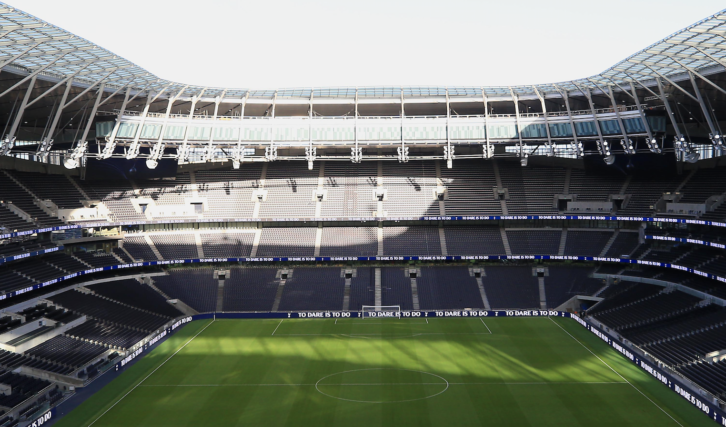
But for the fact that you have to leave the house – pandemics permitting – the stadium experience is increasingly a replication of your own living room. Better, though; because few domestic lounges have the stadium’s range of media luxuries. But essentially today’s stadium AV fuses ever closer the empirical rush of watching sport live with all the augmented reality a couch potato could ever need.
Take, for example, the current benchmark of Eddie Thomas, VP integrated projects (Europe) for SSE Audio and its global parent, Solotech: “At the Tottenham Hotspur Stadium [in London], we have AV, signage and PA all rolled together to direct people through the experience from well outside the stadium at all of its approaches. Even the outside screens are showing the match live for people wandering around the concourses and back-of-house, as well as re-broadcasting Sky Sports previews and round-ups. For the hospitality areas, typically every box has an independent PA system; a wall plate for Smartphone connection; and selectable bespoke media with choices of commentary and other audio sources. The client can sit outside the box in the cold and watch the match or have the same experience inside.”
Thomas acknowledges that all the stadium projects now – or soon – underway exhibit the same design criteria, with particular enhancement built into executive and hospitality areas. “That’s the where the real money’s coming from: corporate entertainment,” he adds.
Not that AV’s contribution is confined to the elite. Everyone visiting gets some of the benefits, which at best support the original sporting function of community and shared emotions. “Today’s venue managers must embrace the entertainment revolution in which expectations are really high,” says Stephen ‘Oggi’ Hogg, a director at d&b audiotechnik GB. “More than ever these primal senses and sensory experiences are recognised for their effect on our emotional wellbeing. Memorable experiences are carefully constructed and enriched with clear, high definition visuals and high-fidelity audio.
“In a venue where we are enveloped by a huge natural soundscape and omnidirectional visual stimuli, larger than life emotional reactions are provoked. Collectively, these crafted technology-powered experiences provide the basis for culture shifting, long-lasting, life-shaping memories.”
“Music and sport go hand in hand,” adds Ryan Penny, senior manager for entertainment, large venues at Harman in the UK, “raising the heart rate and level of excitement. A good audio experience can inspire a crowd even on a cold and damp day at the English Premier League. We see an increased demand for high performance line-array solutions, interestingly matched by a shift in the competitive landscape within the stadium audio market. Customers certainly want a good value solution but the marketing and fan experience stakeholders within a club are involved with the procurement process, and their demands are being captured in consultant specifications.”
The influence of sound quality on any visitor’s experience of any venue is an established marker insists Tom Williams, applications manager, sports facilities at L-Acoustics. “Improving the fan experience in a stadium inevitably means trying to improve the sound throughout the venue,” he says, “and achieving the best possible intelligibility is a major part of that. Beyond improving intelligibility, the ability to provide full range, high quality music reproduction for match-day entertainment helps to build a dynamic atmosphere in the crowd, giving the feeling that a sporting event is part of a larger ‘show’, attracting fans to spend more time at the venue and to keep coming back. On that basis, it’s only logical that concert-grade sound systems are used in these spaces – they can deliver the SPL, the intelligibility and the best quality of sound, allowing large venues to communicate with, engage and entertain their fanbase. Good sound is a strategic contributor to creating experiences that drive people together and keep them coming back.”
Safe as houses
On the other hand, you don’t normally have 60,000 people round to watch the game. So, another key part of the stadium experience is feeling safe. Even today, does that ever compromise the cinematic sweep of match day? “Safety, of course, must take priority,” comments Ben Spurgeon, senior application engineer at QSC’s UK distributor, Audiologic, “but in no way should this limit what can be provided from an entertainment viewpoint. Redundancy is a must when it comes to systems of this size, on both networking and processing fronts. Processing redundancy is created simply by duplicating the existing processor and enabling the primary’s redundant mode. This means that both processors will run duplicate programs ready for the secondary to take the lead in case of primary failure. Network redundancy is achieved by running two separated networks with dual switches in each location, with both running simultaneously. If one network fails, the secondary is already active, meaning there is no audio dropout.
“Creating a compliant system is a necessity but you can continue to expand and develop the system to incorporate as much or as little entertainment as required. With fan engagement becoming an ever-increasing requirement, and the likes of the NFL now utilising UK stadiums, we have the opportunity to take the AV systems to the next level. At large sporting events we’re accustomed to hearing just the PA/VA functionality of the system, with the system in idle the rest of the time. With the processing headroom of Q-Sys, for example, both systems can live within the same DSP providing full integration. The addition of stadium-wide panning and time-based events, as well as integration with pyrotechnic and lighting systems, means we can create a fully immersive experience for every fan.”
Nevertheless, the wider system must satisfy voice and music criteria with no compromise, as Hogg confirms. “For voices, a system must deliver: clarity for commentary; tonality for sponsors’ messages; and the appropriate gravity to generating a response to emergency announcements,” he says. “The quality of reproduced music, often delivering a familiar playlist in the ramp up to the home team’s anthem, can have a defining impact on the fan experience. Finding a sound system to do a good job for voice and music can be a challenge. The conflict is often in the bottom line – but that doesn’t have to be the case with the right system choices.”
“Systems used to be very basic PA,” continues Penny. “Then after a series of tragedies both in sport and transportation people started looking closely at intelligibility and system integrity became prioritised. Many specs for bowl systems ask for the system to augment concert systems meaning that there’s a requirement for safety and entertainment. Of course, you would never choose entertainment over safety, but clients are requesting solutions that meet both criteria.”
It’s the advances in audio technology, Penny believes, that allow for greater flexibility and control of an audio system. Furthermore, an entertainment-focused stadium bowl system should provide the greater level of speech intelligibility that ensures crowd safety. “Further advantages are the increased awareness of system performance and therefore maintenance,” he adds. “However, while the technology has bridged the gap from a construction and building standards point of view there is still room for a more coordinated approach with a greater regulatory framework.”
“It doesn’t make operational sense to have separated VA and entertainment systems,” points out Thomas, “although some people still ask about it. To meet the criteria for emergency standards, anyway, the speakers you use for the PA system would have to be the same as you use for the voice alarm. Production and AV work hand-in-hand with VA.”
Tom Williams confirms this paradigm: “While the life-safety element of any stadium sound system is a must-have, I would not say that it’s the primary requirement. Although there is some variance globally, both safety and entertainment are requirements of a modern stadium sound system, which is the whole point of a dual-purpose PA/VA system. “Typically for a stadium bowl, for the last 15-20 years, pro audio equipment has been made to work in these environments and to meet required life safety standards. Our standard product lines have features that allow us to implement stadium sound system installations, using concert line arrays, that can meet all of the monitoring and reporting functionality required in order for it to be part of a life-safety system. So, the very products that are designed as ‘entertainment systems’ are also fully capable of being safety systems.”
Join the Q
QSC Audio’s Q-Sys media transport and control platform is arguably gaining significant traction in this market, with its demands of harnessing so many disparate steams. Its major strengths contribute directly to the stadium experience, according to Spurgeon. “The Q-LAN protocol itself is built from the ground up around existing IT standards,” he points out. “This makes stadium-wide deployment incredibly straightforward, especially considering we’re bundling all data – audio, video and control – into a single protocol. Take corporate boxes for example: often these have very limited or no media integration contributing to the fan experience. By simply adding peripheral devices onto the network we can incorporate a wide variety of functionality into the boxes, whether it be video streaming, local audio streaming or atmosphere reinforcement from inside the stadium. This can all be controlled on a per-box basis giving each party their own experience, including their own choice of content.”
Glass of wine, remote control in hand… if only the players could be controlled so easily. But this isn’t the Electronic Arts video game FIFA, and the marketing professionals and rights owners driving content towards the stadium AV must appreciate the value of the technology used to deliver the messages that constitute their manipulation of the real-world experience. In the States, if not quite here yet, this extends to Smartphone apps that offer free parking spaces for early arrival – meaning early brand engagement – or that trace your movement through the concessions and message you with special offers nearby.
In this regard, says Penny, the specifications and brand standards of FIFA and UEFA provide a clear indication of the shift towards high-quality audio for major football tournaments. “If you want to host the Euros or the World Cup,” he says, “they insist upon a line array system in every stadium, for example, to deliver an adequate level of audio performance. However, it varies from country to country and between sports. Just think about basketball. Every stadium, and sport, is unique and we need to treat them as such.”
“Marketing professionals definitely recognize the power of sound and audio quality,” adds Hogg. “The full bandwidth film scores found in football boot advertisements are testament to the fact that that advertising companies generating the content know the importance of sound and how it can affect us. They recognise that images alone rarely make the hairs on the back of our necks stand up.”
One important discussion is about the decentralisation of DSP, splitting it between amplifiers to increase protection, improve monitoring and reduce network traffic and channel count. However, Thomas believes that Q-Sys, as one central core, makes programming much easier. “It’s a single platform,” he says, “and you don’t have to budget from one area to another. We use it only as a routing and control matrix; the actual DSP remains in the proprietary amplifiers – although Q-Sys can manage it all if they’re QSC amplifier-processors.”
“With BSS Soundweb London we’ve had decentralised DSP for a number of years – pre-Dante,” points out Penny. “Many systems have been deployed utilizing Blu-link and Cobranet. However, the recent move to Dante has further developed this trend. System optimization has really improved with the latest generational shift in stadium planning: our Soundweb installations at stadiums like The Emirates in London, Croke Park in Dublin and The All England Lawn Tennis Club at Wimbledon all exploit the audio quality and low-latency on offer to make visiting a much more rewarding experience. And the advantages extend beyond the bowl audio system and are particularly powerful for multi-functional areas such as hospitality and conferencing spaces.”
Best of all, just like home, you’re never too far from a fridge. First service…







